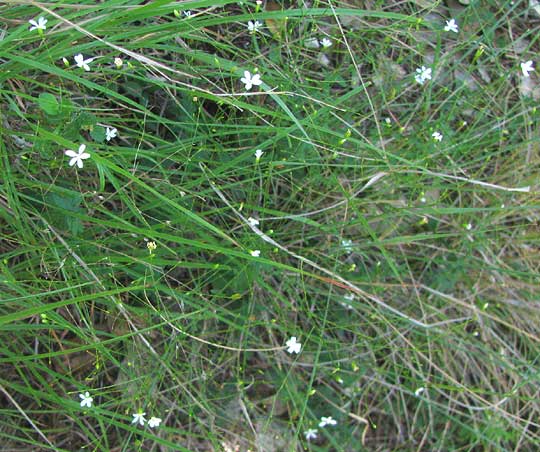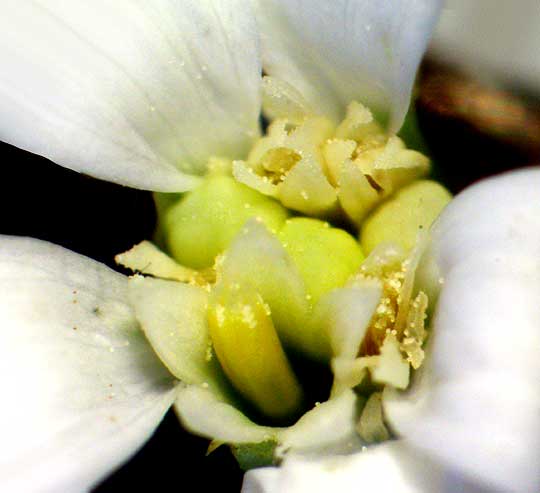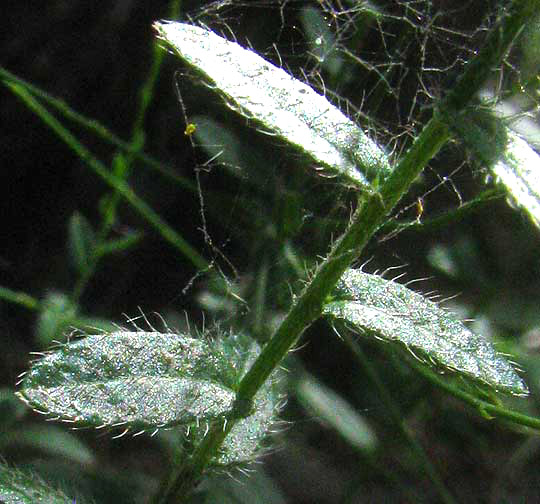Excerpts from Jim Conrad's
Naturalist Newsletter
from the August 11, 2013 Newsletter issued from the Frio Canyon Nature Education Center in the valley of the Dry Frio River in northern Uvalde County, southwestern Texas, on the southern border of the Edwards Plateau; elevation ~1750m (~5750 ft); N29.62°, W99.86°; USA
SPREADING LAZY-DAISY
On our limestone hill where Ash Junipers and Texas Liveoaks thin so that house-size grassy areas break out, sometimes the grass is punctuated with a sprinkling of half-inch-wide
(12mm), white flowers as shown below:

Such small, disperse flowers put one in the mind of bluets or similar wildflowers, maybe of the Pink Family, the Caryophyllaceae, but if you get on your hands and knees and look closely at a blossom, you don't see what you expect. A shot from below a blossom is shown below:

There, instead of seeing a green calyx with five sepals subtending a white corolla, you find sharp-pointed, overlapping scales of differing sizes. This is as you'd find in the big Composite or Sunflower Family, but flowering heads in that family seldom are so small and positioned in such and open, diffuse inflorescense. However, when you flip over the blossom and look at it from above you see what's shown below:

That's the "eye" of a blossom as seen beneath a dissecting scope. The yellow eye is surrounded by the bases of five white "ray flowers," and the eye itself comprises seven or eight "disc flowers," one of which is open. The open disc flower clearly displays five sharp-pointed corolla lobes, and five yellow anthers fused along their edges to form a cylinder, exactly as is normal for flowers in flowering heads of the Composite Family. This really is a composite flower, after all.
Before plunging into "doing the botany" on these tiny flowers I made special note that the wildflower's individual flowering heads appeared at the tips of exceedingly long, slender stems, or peduncles, in a much-branched, very open, panicle-type inflorescence. The panicle was several times higher than the plant's modest leafy stem, and the stem and leaves themselves were heavily invested with stiff, slender hairs, as shown below:

Having never met this kind of composite before and with the flower parts being so tiny, this was a hard ID to make! Still, in the end the plant revealed itself as CHAETOPAPPA EFFUSA, in books referred to as the Spreading Lazy-Daisy or Spreading Leastdaisy. It's a poorly documented and little-known species, mainly because in the whole world it's endemic to just a dozen or so counties here in southwestern Texas, in the Edwards Plateau region. The online Flora of North America describes its habitat as "Limestone cliffs, ledges, bluffs, steep hillsides, sometimes in seepy areas, oak-juniper, oak, or mixed deciduous woods; 300–500 m," which is exactly where we find it.
The genus Chaetopappa comprises eleven species occurring only in arid northern Mexico and the south-central and southwestern US. In Uvalde County we have three species, so in our area Chaetopappa is a genus worth knowing.